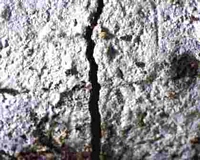|
 Phlebiella tulasnelloidea Phlebiella tulasnelloidea
SynonymsCorticium tulasnelloideum
Xenasmatella tulasnelloidea
Phlebiella tulasnelloidea
BiostatusPresent in region - Indigenous. Non endemic
Images (click to enlarge)
Caption: Phlebiella tulasnelloidea, BCP 1848
Owner: B.C. Paulus | 
Caption: Phlebiella tulasnelloida pleural base, BCP 702
Owner: B.C. Paulus |
Article: Cunningham, G.H. (1963). The Thelephoraceae of Australia and New Zealand. New Zealand Department of Scientific and Industrial Research, Bulletin 145: 359 p. Wellington:.
Description: Hymenophore annual,
arachnoid, closely adherent, effused forming irregular areas to 5 x 3 cm;
hymenial surface at first dingy white, becoming grey or bluish-grey, irregularly
granular, not creviced; margin thinning out, arachnoid, white, adherent. Context
white, 10-100 µm thick, commonly 10-20 µm, basal layer narrow, of densely
arranged parallel hyphae, intermediate layer wanting; generative hyphae 3-3.5 µm
diameter, walls 0.2 µm thick, sometimes inflated between septa, naked, with
clamp connections. Hymenial layer to 30 µm deep, a scanty palisade of basidia
and paraphyses. Basidia subclavate or subcylindrical, 8-16 x 4-6 µm, bearing 4
spores; sterigmata slender, to 7 µm long. Paraphyses subclavate, 6-10 x 4-5 µm.
Spores globose, subglobose, or obovate, 4.5-5.5 x 4-4.5 µm, walls echinulate,
0.5 µm thick.
Habitat: HABITAT: Effused on bark or: decorticated
dead wood.
Distribution: DISTRIBUTION: Europe, Great Britain, North America, Australia, New
Zealand.
Notes: Specific features are
the echinulate, subglobose, or obovate spores, small basidia, subclavate or
elliptical paraphyses, non-creviced surface which on a dark substratum appears
as a delicate grey or bluish-grey arachnoid film, and absence of an intermediate
layer. Appreciable variations were noted in specimens examined, particularly in
thickness of the context, shape and size of spores, and presence or absence of
ampullae on context hyphae. The context is reduced to a basal layer of mainly
parallel hyphae, which soon collapse and become pseudoparenchymatous. Spores
are.similar in size and echinulations to those of C. sulphureum,
differing mainly in shape and finer spines.
|